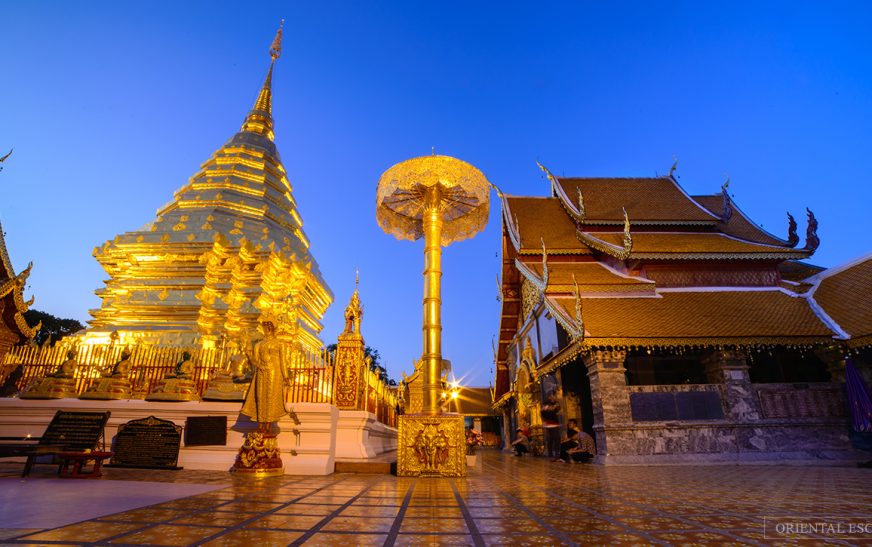Doi Suthep Temple Thailand: Nestled on the slopes of Doi Suthep Mountain, just outside of Chiang Mai, Thailand, Wat Phra That Doi Suthep, commonly known as Doi Suthep Temple, is one of the country’s most revered and stunning temples. Established in the 14th century, it holds significant spiritual and cultural importance. Visiting this temple offers an incredible opportunity to immerse yourself in Thai culture, history, and architecture. Here’s a detailed guide to the ten must-see features and attractions of Doi Suthep Temple, ensuring a memorable and enriching experience.
Doi Suthep Temple Thailand: The Golden Chedi
The centerpiece of Doi Suthep Temple is the magnificent golden chedi (stupa), which stands proudly at the temple’s core. This towering structure, adorned with intricate designs and covered in gold leaf, is a beacon of Thai religious artistry. The chedi is believed to house a relic of the Buddha, making it a sacred site for pilgrims and tourists alike. The golden glow of the chedi, especially during sunset, creates a breathtaking visual that’s not to be missed.
Doi Suthep Temple Thailand: The Naga Serpent Staircase
One of the most iconic features of Doi Suthep Temple is the grand staircase lined with naga (serpent) statues. The staircase, which consists of 306 steps, is flanked by these mythical creatures, symbolizing protection and guidance. Climbing the staircase provides not only a spiritual journey but also an opportunity to appreciate the detailed craftsmanship of the naga statues. The ascent offers a sense of anticipation and reverence as you approach the temple’s sacred grounds.
The Temple’s Bell Tower
Situated near the temple’s entrance, the bell tower is a striking structure that adds to the temple’s serene atmosphere. It features a traditional Thai design and is used for ringing bells during ceremonies and religious rituals. The sound of the bells resonates through the temple complex, creating a peaceful and meditative environment. The bell tower’s architectural elegance and the spiritual significance of its sound make it a noteworthy feature of the temple.
The Main Prayer Hall
The main prayer hall, or ubosot, is a central area where visitors can observe monks performing daily rituals and worshippers engaging in prayer. This hall is adorned with beautiful murals depicting scenes from Buddhist scriptures and Thai mythology. The interior of the prayer hall is richly decorated with intricate wood carvings, golden accents, and sacred relics. It provides a tranquil space for contemplation and a glimpse into the spiritual life of the temple.
Doi Suthep Temple Thailand: The Holy Well
Doi Suthep Temple is home to a sacred well, which is believed to possess healing properties. Pilgrims and visitors often come to the well to offer prayers and collect water, which is considered holy. The well is located in a serene corner of the temple complex, surrounded by lush greenery. Its spiritual significance and the tranquil setting make it a special spot to visit during your tour of the temple.
The Temple Museum
Adjacent to the main temple area is a small museum that showcases artifacts, historical documents, and religious items related to Doi Suthep and Thai Buddhism. The museum provides valuable insights into the history of the temple, its cultural heritage, and the evolution of Thai religious practices. Exhibits include ancient manuscripts, ceremonial objects, and photographs that offer a deeper understanding of the temple’s significance.
The Bodhi Tree
The Bodhi tree, located within the temple grounds, is a revered symbol of enlightenment in Buddhism. It is said to be a descendant of the original Bodhi tree under which the Buddha attained enlightenment. Visitors often pause to meditate or offer prayers beneath its branches. The serene and shaded area around the Bodhi tree provides a peaceful retreat and a space for reflection.
The Surrounding Views
From its elevated position on Doi Suthep Mountain, the temple offers panoramic views of Chiang Mai and the surrounding countryside. On a clear day, you can see the sprawling city below and the lush landscape that extends into the distance. The observation points around the temple are perfect for taking photographs and enjoying the natural beauty of the region.
The Monk’s Quarters
The monk’s quarters at Doi Suthep Temple provide a glimpse into the daily lives of the temple’s resident monks. While access to these areas is typically restricted, you can observe the monks’ activities from designated viewing spots. The quarters are simple yet functional, reflecting the monastic lifestyle and discipline. Observing the monks’ practices offers a deeper appreciation for the spiritual traditions upheld at Doi Suthep.
Doi Suthep Temple Thailand: The Gift Shops and Stalls
The area surrounding Doi Suthep Temple features various gift shops and stalls where visitors can purchase souvenirs, religious artifacts, and local crafts. These shops offer items such as Buddhist amulets, handcrafted jewelry, and traditional Thai textiles. Exploring these stalls provides an opportunity to support local artisans and bring home a memento of your visit.
Conclusion
Doi Suthep Temple Thailand: Doi Suthep Temple is a jewel of Thai cultural and spiritual heritage, offering a rich tapestry of history, art, and devotion. From the golden chedi and the naga serpent staircase to the serene Bodhi tree and the panoramic views, each feature of the temple contributes to its profound charm and significance. Whether you are seeking spiritual solace, cultural insights, or simply a beautiful place to visit, Doi Suthep Temple promises an unforgettable experience. As you explore these ten must-see features, you’ll gain a deeper appreciation for the temple’s enduring beauty and its role in Thai Buddhism.
FAQs
1. How do I get to Doi Suthep Temple from Chiang Mai?
You can reach Doi Suthep Temple from Chiang Mai by taking a taxi, songthaew (red truck), or renting a motorbike. The drive takes about 30 to 45 minutes. Many local tour operators also offer guided tours to the temple.
2. Is there an entrance fee for Doi Suthep Temple?
Yes, there is a small entrance fee for Doi Suthep Temple, which is used for maintenance and conservation. The fee is generally around 30-50 THB (approximately 1-2 USD). There may also be additional fees for parking and for taking photos.
3. What is the best time to visit Doi Suthep Temple?
The best time to visit Doi Suthep Temple is early in the morning or late afternoon to avoid large crowds and to enjoy cooler temperatures. The temple is open daily from 6 AM to 6 PM.
4. What should I wear when visiting Doi Suthep Temple?
Visitors are expected to dress modestly when visiting Doi Suthep Temple. Wear clothing that covers your shoulders and knees. Avoid wearing revealing or sleeveless attire. It is also respectful to remove your shoes before entering certain areas of the temple.
5. Are there any dining options at or near Doi Suthep Temple?
There are no large dining facilities within the temple grounds, but there are small food stalls and local eateries near the temple where you can purchase snacks and beverages. For more extensive dining options, it is recommended to return to Chiang Mai city.
Also read: Nacpan Beach Guide: 10 Must-See Spots for a Perfect Day in Paradise










